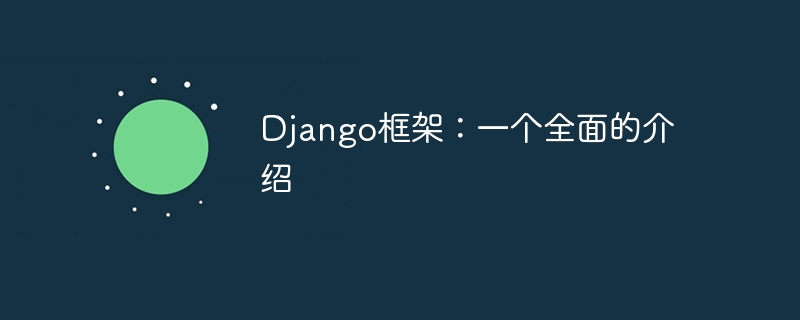

Django Framework: A Comprehensive Introduction
Django is one of the most popular and widely used web development frameworks in Python. It is a powerful, efficient, free and open source architecture that can help web developers quickly build high-quality web applications. With Django, developers can easily manage all aspects of web applications, including URL routing, model management, template rendering, form processing, security protection, and more.
In this article, we will provide a comprehensive introduction to the main components, features and usage of the Django framework, including code examples and explanations.
First, we need to install Django. Django can be easily installed using the pip tool. Just enter the following command on the command line:
pip install django
After the installation is complete, you can use the following command to verify whether Django has been installed successfully:
python -m django --version
If the version number of Django is output, it means Django Installed successfully.
To create a web application using the Django framework, you need to create a Django project first. In Django, a project is the overall architecture of a web application, including applications, configuration files, templates, static files, etc. Execute the following command on the command line to create a Django project:
django-admin startproject myproject
The above command will create a Django project named "myproject".
After creating the Django project, you can start the Django development server in the development environment through the following command:
python manage.py runserver
This command will Start a local server and run the Django project on the default port 8000.
Django applications are components of web applications, and each application has its own functionality and data model. In Django, a project can contain multiple applications. Use the following command in a Django project to create an application:
python manage.py startapp myapp
This command will create a Django application named "myapp".
Django views are one of the core parts of a web application and determine the behavior and output of the application. A view can be a function or a class. Django views can use the following code to declare a view function:
from django.http import HttpResponse
def my_view(request):
return HttpResponse('Hello, World!')This view function will return a "Hello, World!" text message to the browser when the request arrives.
In Django, URL routing determines how to respond to URL requests from a web application. A URL route can be declared using the following code:
from django.urls import path
from . import views
urlpatterns = [
path('hello/', views.my_view, name='hello'),
]This URL route will respond to requests for the URL "/hello/" and send the request to the view function named "my_view".
Django templates are another core part of a web application and are used for rendering and rendering HTML pages. You can use the following code to declare a Django template:
<html>
<head>
<title>{{ title }}</title>
</head>
<body>
<h1>{{ message }}</h1>
</body>
</html>This template contains two placeholders. Using Django's template engine, the placeholders in the template can be replaced with actual values at runtime.
When accessing the view, you can use the following code to pass variables to the Django template:
from django.shortcuts import render
def my_view(request):
context = {
'title': 'Welcome to my app!',
'message': 'Hello, World!',
}
return render(request, 'my_template.html', context)This view function will pass a A dictionary object is passed to the template, and the template engine is used to replace the values in the dictionary object with placeholders in the template.
The above is the introduction and usage of the basic Django framework. Through these examples, you can have a basic understanding of Django. In practical applications, the Django framework can implement more complex web applications. Django is a comprehensive web development framework that provides many functions, including model management, form processing, data validation, security protection, etc. With Django, developers can easily create high-quality web applications.
The above is the detailed content of Django framework: a comprehensive introduction. For more information, please follow other related articles on the PHP Chinese website!